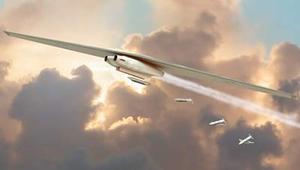Search and rescueShape-shifting UAV for maritime search and rescue missions
Use of morphing flight surfaces has enabled the development of a shape-shifting UAV that can operate in extreme weather conditions; cutting-edge avionics ensure a smooth flight for extended rescue and surveillance missions, while reducing risks to material and crews

The UAV will use the same technology as this bomber // Source: livescience.com
The EUREKA E! 3931 ASARP project has developed a small and cheap-to-build UAV intended to cut the cost of maritime search-and-rescue missions and reduce risks to material and human lives. The seaplane uses shape-changing technology to improve flight stability, enabling the plane to fly in severe weather conditions. The resulting craft has an endurance of 4.5 hours with a payload of up to 40 kg. It is equipped with state-of-the-art avionics and onboard cameras. It is linked wirelessly to the command centre from where the pilot can control the UAV.
Eureka reports that a prototype is currently undergoing final trials in Cyprus and the design is already attracting interest from governmental and civil rescue and surveillance organizations.
Maritime search and rescue is often hampered by severe weather, posing a major risk to helicopters or fixed-wing aircraft and their crews. The cost in material and human life can prove high. ASARP set out to design a UAV to undertake such rescue missions more effectively.
“The main problem is that UAVs are small, light and affected by extreme weather,” explains project coordinator Dr. Michael Amprikidis of engineering consultancy GGD. ASARP tackled this by using reactive shape-changing control surfaces. The shape-changing elements of the plane are aeroservoelastic trim tabs which can be vibrated in counterphase to wind gusts to reduce loads by as much 25 percent, allowing the UAV to fly in severe weather. On-board sensors monitor stability and provide constant feedback to the ailerons.
“Aeroservoelastic technology makes it possible to use wind speed and the structural mechanics of the system to our advantage,” says Amprikidis.
The technology was the subject of a previous project in which he evaluated design concepts involving aeroelastic deformation of the airframe enabling aircraft to withstand heavy winds. Optimum efficiency was obtained through continual adjustment of the aircraft shape.
“Several technologies were used, including aeroservoelastic trim tabs,” he says. This involves three deformable surfaces used in conjunction with the flight controls and able to move at high frequencies. “A tab can have very high oscillation frequency; traditional flight surfaces cannot match these frequencies, leading to up-and-down movement of aircraft during turbulence.”
Eureka notes that these trim tabs counteract the effect of a gust by moving in the opposite phase to keep the aircraft steady. This was the key to making ASARP UAVs stable in extreme weather conditions.
